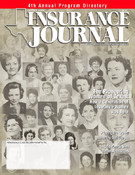Some insurance stories should be easy to write. Say, when an insurance company buys another insurance company. Representatives from both companies are always more than willing to tell reporters how the match was heaven-made, how no one will “lose” their job, how integration will be “seamless.” But that’s often as easy as it gets. Ask about duplication of offices, plans for product distribution and other taxing subjects, and you’re likely to be trading phone calls from public relation flaks well past your deadline.
I say such ungracious things because it’s often the nature of the beast. And it happened just a few weeks ago. An entity with an excess of 100 corporate executives couldn’t find someone in four days time to comment on their company’s sale. But this is nothing new and will happen again.
Large entities release information they want to release. They are often accused of not disclosing things imperative to true understanding of a company’s health. There are currently a large handful of insurance entities fighting class action shareholder lawsuits that allege important information was not disclosed. The defendants range in size from insurance giant Chubb Corp. to Texas’ homespun Unistar Financial Services.
While the Information Age might not change an insured’s reliance on their independent agent, it will change—is changing—what they expect from that agent and from their company. Information. At any time. On their terms.
All of these thoughts entered my head as I read a recent article in Schiff’s Insurance Observer, and now serve as an awkward segue into the contents of that article. Isaac Schwartz, in the September edition, began with the premise that important public documents should be available to the public in a relatively accessible format. He chose to pursue insurance company’s annual statements. These statements must be filed with the National Association of Insurance Commissioners (NAIC) and with each state with which the company is licensed to do business. By March 1 of each year, companies must have submitted information from the prior year.
The annual statement is not the same as an annual report. The statement includes premiums and losses by line of business, investment schedules, reinsurance information, resisted claims data and much more, all of which is needed to analyze a company’s health.
Mr. Schwartz called 17 insurance carriers for their annual statements. Nine of them sent them. Some of those that didn’t send the statement sent their annual report instead. Some of those that did send the statement had to be called several times.
There are other ways to get the information. Through the NAIC, you can purchase the documents for $1.50 a page. As Schwartz points out, one annual statement, for instance National Union’s at 349 pages, could cost in excess of $500. Going through individual state DOI’s is a bit cheaper. For instance, Texas charges 25 cents per page. The same NU statement would cost around $84.
Perhaps the most cogent part of Mr. Schwartz’s report on statements was what other financial services and government entities are doing. The Securities and Exchange Commission created the EDGAR database in 1995 to keep up with all of information filed with the SEC—including information for more than 12,000 companies. It’s all free. The Federal Deposit Insurance Corp. makes quarterly financial statements free for all of those interested. Schwartz wonders why the insurance industry keeps all of this information, much of it already sent electronically, from the people who ultimately need it. I wonder right along with him.
I’m often prone to say it’s all about the ball bearings. But here I will agree with Mr. Schwartz. It’s all about information.
Was this article valuable?
Here are more articles you may enjoy.


 State Insurance Legislators ‘Greatly Disturbed’ by Trump AI Regulation Order
State Insurance Legislators ‘Greatly Disturbed’ by Trump AI Regulation Order  Catastrophe Bonds Linked to Wildfires Lose ‘Untouchable’ Status
Catastrophe Bonds Linked to Wildfires Lose ‘Untouchable’ Status  UPS Ripped Off Seasonal Workers With Unfair Pay Practices, Lawsuit Alleges
UPS Ripped Off Seasonal Workers With Unfair Pay Practices, Lawsuit Alleges  ‘Door Knocker’ Roofers Were Everywhere. NC Farm Bureau Saw an Opportunity
‘Door Knocker’ Roofers Were Everywhere. NC Farm Bureau Saw an Opportunity 


